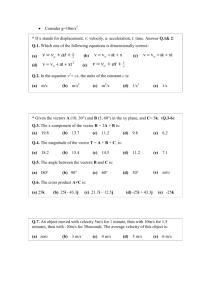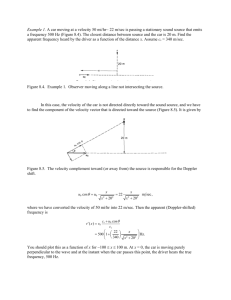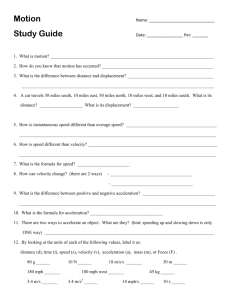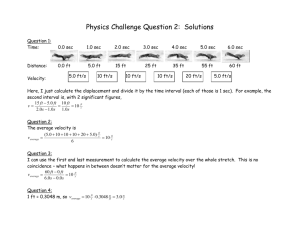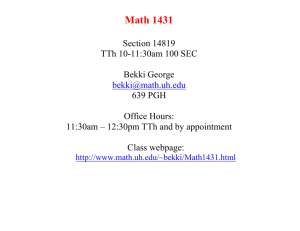PPT
advertisement
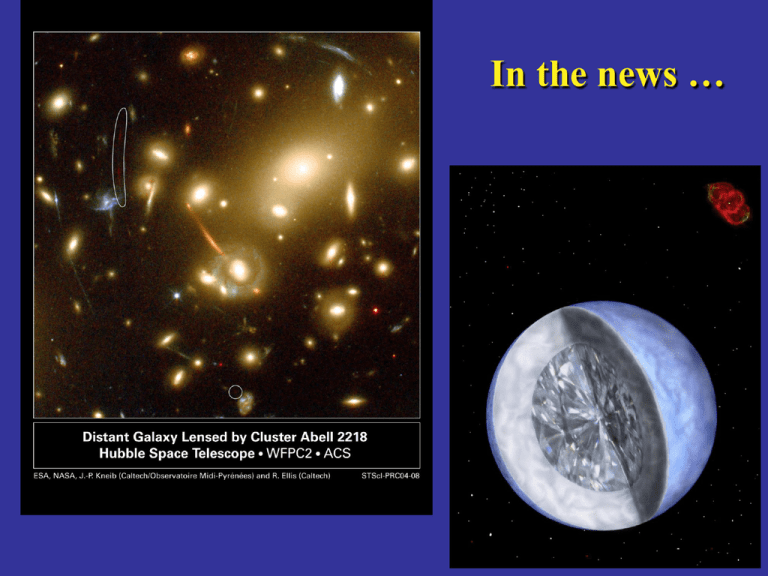
In the news … Bit of Administration …. • Reading – Bless, pp. 105-139 – BNSV, pp. 70-83 • Observing Lab – Start Lab 2 on Saturday • Timing Matters! Must be nearly same time every night. • 10 minutes every clear night for two weeks. Kepler’s Three Laws of Planetary Motion 1. The Orbits of the Planets are Ellipses with the Sun at One Focus ConcepTest! Which of the following orbits has the smallest eccentricity? A) B) e=0 D) All have the same eccentricity. C) e = 0. 4 e = 0.8 ConcepTest! Which of the following orbits has the smallest semi-major axis? A) B) D) All have the same semi-major axis. C) Kepler’s Three Laws of Planetary Motion 2. The Line Joining The Sun and A Planet Sweeps Out Equal Areas in Equal Times 30 days 30 days ConcepTest! The Earth is somewhat closer to the Sun in (northern) winter than in summer. Kepler’s Second Law tells us that the Sun should appear in winter to A. B. C. D. Move faster west to east during each day. Move faster east to west during each day. Move slower west to east during each day. Move slower east to west during each day. Kepler’s Three Laws of Planetary Motion 3. The Square of a Planet’s Period (P in Years) Equals the Cube of the Semi-Major Axis of its Orbit (A in AU) P2 = A3 P2=A3 A 1 ConcepTest! Comet Halley has an orbital period of 76 years. Its semi-major axis is A) less than the semi-major axis of the orbit of the Earth B) less than the semi-major axis of the orbit of Mars C) less than the semi-major axis of the orbit of Neptune D) unknown without information about the orbital eccentricity A 1 The Birth of Modern Physics • Aristotle Redux A body at rest stays at rest; a body in motion will come to rest. Rest is the natural state of matter Movement happens only in the presence of a force • Galileo - The Father of Experimental Physics Law of Inertia Bodies in undisturbed motion stay in motion (But celestial bodies move with uniform circular motion, being imbued with “circular inertia”) The Birth of Modern Physics • Mechanics - The Study of Motions and Forces – Fundamental Concepts • Mass - Amount of matter • Inertia - Property of matter requiring a force to change motion “Resistance to Force” The Birth of Modern Physics • Mechanics - The Study of Motions and Forces – Fundamental Concepts • Mass - Amount of matter • Inertia - Property of matter requiring a force to change motion • Position - Location in space - Absolute reference frame; a Cartesian concept • Velocity - Rate at which position changes - Defined by both speed and direction • Acceleration - Rate at which velocity changes The Birth of Modern Physics • Acceleration - Rate at which velocity changes – Change of Speed 1. Parked car: Acceleration = 0 (km/hr)/sec 2. Car at constant speed of 100 km/hr: Acceleration = 0 (km/hr)/sec 3. Car going from 0 km/hr to 100 km/hr in 10 seconds Acceleration = (change in velocity)/(change in time) = 100 km/hr / 10 sec = 10 (km/hr)/sec 4. Drop a ball … • Acceleration - Rate at which velocity changes 4. Drop a ball … t (sec) d v a 0 0 cm 0 cm/sec 1 490 cm 980 cm/sec 980 (cm/sec)/sec 2 1960 cm 1960 cm/sec 980 (cm/sec)/sec 3 4410 cm 2940 cm/sec 980 (cm/sec)/sec ConcepTest! You throw a ball straight up in the air. It goes up, momentarily stops, and then falls back toward you. During its flight A. B. C. D. The ball is accelerating at all times The ball is accelerating except for that moment when it stops The ball is only accelerating on the way back down The ball is never accelerating The Birth of Modern Physics • Aristotle Heavy objects fall faster • Galileo All objects fall at the same constant acceleration The Birth of Modern Physics • Acceleration - Rate at which velocity changes – Change of Direction 10 km/hr 10 km/hr The Birth of Modern Physics • Mechanics - The Study of Motions and Forces – Fundamental Concepts • Mass - Amount of matter • Inertia - Property of Matter Requiring a Force to Change Motion • Position - Location in space - Absolute reference frame a Cartesian concept • Velocity - Rate at which position changes - Identified by both speed and direction • Acceleration - Rate at which velocity changes • Central Force The Birth of Modern Physics • Central Force m v R Fc = m v2 / R The Birth of Modern Physics • Central Force Fc = m v2 / R ConcepTest! You are holding your little brother by his hands and swinging him around you. To increase his “excitement”, you begin to swing him faster. You have to grip his hands more tightly because A. His mass has increased with the increased speed B. The radius of his circle around you has increased C. You need to provide more central force to keep him moving in a circle D. You need to pull harder to keep him in a circle. E. Both C and D The Birth of Modern Physics • Central Force (also known as Centripetal Force) – Central force required to keep object moving in a circle Fc = m v2 / R The Birth of Modern Physics • Newton 1700 AD 1665-1666 plague was sweeping England … left Cambridge for home … in next five years he developed his ideas on …. Mechanics Gravity Calculus Discovered Spectrum of Light Theory of Light Reflecting Telescope Newton’s Laws of Motion 1. A Body Remains at Rest or Moves at Uniform Speed in a Straight Line unless acted Upon by a Force. ConcepTest! The little brother that you are swinging around is beginning to annoy you. So you let go! After you let go, he will A. Continue to travel in a circle until he hits the ground B. Travel in a spiral pattern away from you until he hits the ground C. Travel in a straight line until he hits the ground D. Drop to the ground right where you let go of him The Birth of Modern Physics • Central Force Newton’s Laws of Motion 2. The Change of Motion is Proportional to the Force Acting on it and in the Direction of the Force F=ma 4. Drop a ball … t (sec) d v a 0 0 0 1 490 cm 980 cm/sec 980 (cm/sec)/sec 2 1960 cm 1960 cm/sec 980 (cm/sec)/sec 3 4410 cm 2940 cm/sec 980 (cm/sec)/sec Change of Direction 10 km/hr 10 km/hr ConcepTest! Consider again the falling ball with constant accleration. From this experiment we know that A. The force of gravity increases closer to the ground B. The force of gravity is constant over the distance the ball drops C. The force of gravity decreases closer to the ground Newton’s Laws of Motion 3. To Every Action there is an Equal and Opposite Reaction Newton’s Laws of Motion 3. To Every Action there is an Equal and Opposite Reaction • • • Recoil of a gun Collisions Rockets ConcepTest! You are an astronaut taking a spacewalk to fix your spacecraft with a hammer. Your lifeline breaks and the jets on your back are out of fuel. To return safely to your spacecraft you should A. Throw your hammer at your spacecraft to get someone’s attention B. Throw your hammer away from the space ship C. Use a swimming motion with your arms D. Kiss your spacecraft good bye
